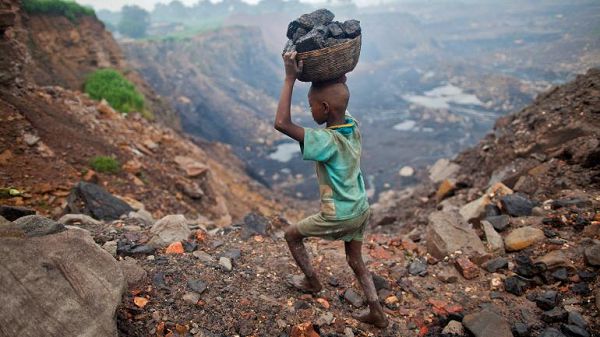Can Ghana Meet Deadline To End Child Labour In 2015?
- Home
- Can Ghana Meet Deadline To End Child Labour In 2015?

Can Ghana Meet Deadline To End Child Labour In 2015?
 Today, February 20, is being observed as the The World Day of Social Justice. The observance is coming at a time the global community is saddled with the problem of delivering social justice to 152 million child labourers and 40 million people in modern slavery.
Today, February 20, is being observed as the The World Day of Social Justice. The observance is coming at a time the global community is saddled with the problem of delivering social justice to 152 million child labourers and 40 million people in modern slavery.
The General Assembly Recognizes that social development and social justice are indispensable for the achievement and maintenance of peace and security within and among nations and that, in turn, social development and social justice cannot be attained in the absence of peace and security or in the absence of respect for all human rights and fundamental freedoms.
This means the issue of child labour which is of particular interest to Ghana because it is common at the cocoa growing areas, cannot be separated from the major challenges confronting the world. Indeed, there have been persistent calls to UN member states “to take immediate and effective measures to eradicate forced labour, end modern slavery and human trafficking and secure the prohibition and elimination of the worst forms of child labour, including recruitment and use of child soldiers, and by 2025 end child labour in all its forms.Thus, eliminating child labour has become part of the UNSustainable Development Goals (SDG’S) and this has imposed an obligation on the world to end it by 2025 (at all cost?). .
Ahead of meeting 2025 deadline is the UN unanimous resolution declaring 2021 as the International Year for the Elimination of Child Labour. The resolution enjoins the International Labour Organization (ILO) to take the lead in its implementation.
From the perspectives of the International Labour Organization ILO, ”Issues of poverty, unemployment, and unfair exclusion results in economic harm or social ostracism.”
In fulfilment of this task, It may be recalled that the ILO’s 14th Africa Regional Meeting in Abidjan, Côte d’Ivoire in November 2019, ended with a declaration calling for the shaping of an African Decent Work Agenda, with a focus on five core priorities one of which is : “Making decent work a reality for Africa’s youth; developing skills, technological pathways and productivity for a brighter future in Africa; transforming the informal and rural economy for decent work; respecting international labour standards; promoting social dialogue and gender equality.
The meeting which climaxed the ILO’s Centenary celebrations in 2019, created a platform for
organization’s own mantra to reverberate: “Seeing parents at work and children at school”.
In Ghana, children being used as labourers especially, in the cocoa growing areas are counted in the thousands and we are under international pressure to deal with the issue as it affects the cocoa industry. Fortunately, a collaboration deal has been struck with neighbouring Cote D’Ivoire that will ensure that the two countries who are the world’s two cocoa producers have joined forces to end all forms of child labour to sustain the cocoa industry.
The fight to win the battle against child labour, by all account, is a daunting task and the question has always been asked: Can Ghana meet the 2025 deadline to end it?.
The reality is that meeting the ILO’s expectation to see “parents at work and children at school” by 2025 may not be crowned with a success story expected in five years.
It is clear that the commitment being shown in meeting the ILO’s expectation is grinding slowly. At a recent meeting in Accra stakeholders working on the creation of Child LabourFree Zones (CLFZ’s) in Ghana to measure progress of the framework being developed were told that “Ghana is losing the fight against the eradication of child labour.”
Minister of Employment and Labour Relations who was addressing Civil Society Organisations and other stakeholders at the validation of protocols and guidelines on the establishment of the CLFZ’s disclosed that, “We (Ghanaians) are losing the fight and it is an indictment on everyone, especially children who are at the receiving end.”
Mr. Ignatius Baffour Awuah told the bemused gathering including representatives of some foreign donor organizations that there was “Insufficient efforts to sustain the fight.”
He kept the gathering including representatives from, Deloitte-Japan, Action Against Child Exploitation (ACE), Child Research for Action and Development Agency (CRADA) and International Labour Organization (ILO) who have pumped in so much money to sustain the drive to reduce the menace guessing what might be the exact cause of “losing the fight. “
The Minister’s explanation was that, “It is either our efforts are not enough or we are pretending to be working and the problem keeps surfacing.”
The Employment Minister’s advice to stakeholders in the fight to eliminate child labour , was for them to “sit-up and carry-out interventions that would have bigger impacts to help reduce the occurrence and not the contrary.”
We are in 2020 and by the end of this year, the worst forms of child labour per the ILO Convention 182 in the cocoa sector of Ghana and Cote d’Ivoire would have been reduced by 70 percent.
Now to the crucial question: What has made it difficult for both government and Non-Governmental Organisations and their partners who are playing key collaborative roles to minimize child labour to make significant inroads? Somehow I agree with the Employment and Labour Relations Minister said: “It is either our efforts are not enough or we are pretending to be working and the problem keeps surfacing.”
I have directly been involved in planning various strategies with stake holders in the fight against child labour both on the drawing board and during conferences at home in Ghana and abroad. Besides, I have been in the bush as part of CRADA’s outreach programmes in fulfilling our core mandate of supporting the government of Ghana’s drive to build and improve the welfare of all children and young people, particularly those in the rural and urban most disadvantaged communities. The ultimate goal is to help them become more responsive, more interactive and more relevant to the socio economic realities and national aspiration.
CRADA is engaged in this social work because of our believe that “All children have the right to be protected against any form of exploitation and that children have the to grow up within a loving , caring and enabling family environment and not working on plantations.
Regrettably, I must admit that “We are losing the fight” as the Minister rightly pointed out. The reasons are as follows: We still have a long way to go in meeting the objectives set to achieve the sustainable Development Goal Target 8.7 because of these challenges: Remediation services which would ensure that education and livelihood services are extended to the child labour zones have still not been rendered thus, creating a huge gap in meeting the aspirations of the major stake holders.
As part of the protective measures, those of legal working age and engaged in hazardous labour and battling with occupational safety have to be withdrawn and provided with safe and acceptable work in conformity with both national laws and international labour standards but this has also not been done.. In the case of children who are victims of trafficking, they are yet to be provided with social protection services in the form of rehabilitation and repatriation in the communities where they with.
I am convinced that when the Child Labour Free Zone (CFLZ) whose document will soon be launched is finally created, there will be more commitment on the part of all the stake holders to up their game.
I am convinced that since the government cannot make adequate provision to deal with all the challenges, the support of NGO’s and their partners who are engaged in field activities to end child labour and related issues would be forthcoming. Donor support for eliminating Child labour or child trafficking should not be limited to only the few partners.
As we celebrate the event, Ghanaians have to take note that The global community is not enthused at finding millions of childrentrapped in worst forms of child labour/trafficking situations particularly, in the cocoa producing countries such as Ghana andCote d’Ivoire. The phenomenon is entrenched. Added to this we, as a key stake holder, have an obligation imposed by the UN. The obligation is rooted in its statement which reads;
“Achieving commitments under the Sustainable Development Goals (SDGs) to end child labour, forced labour and human trafficking requires that governments, business, the financial sector and civil society take strong action to address the root causes and determinants of these human rights violations. While global supply chains have the potential to generate growth, employment, skill development and technological transfer, they have also been linked to human rights violations and abuses.”
The writer is the Executive Secretary of CRADA, Kumasi.
Source: Graphic Online
- Share
Classic Ghana
Classic Ghana brings you into a fun world of arts, entertainment, fashion, beauty, photography, culture and all things in between. Let’s explore these together!







